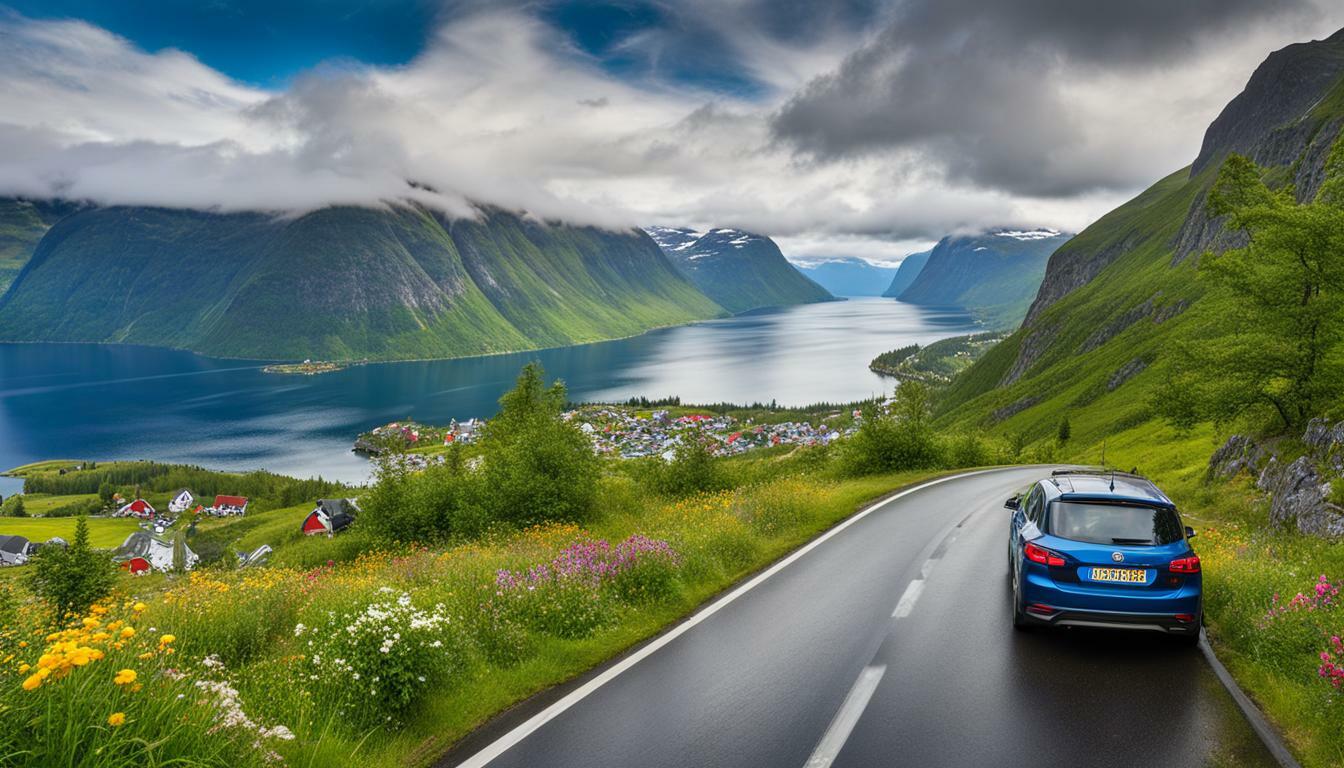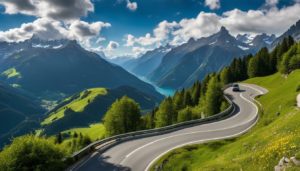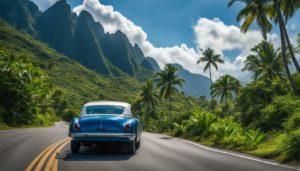Driving in Norway
Are you ready for an unforgettable driving adventure in Norway?
Driving in Norway is generally easy and the roads are well-maintained. Norwegians drive on the right side of the road, and safety regulations such as wearing seat belts and using low-beam headlights at all times are strictly enforced. It is prohibited to talk on mobile phones while driving, and drinking and driving is severely punished. Parking restrictions are strict, and parking fines can be costly.
Speed limits are posted in kilometers per hour (km/h), and fines for speeding are steep. Norway has a toll road system, and rental cars are equipped with AutoPASS devices to pass through toll booths without stopping. There are many road tunnels in Norway, and mountain passes can be steep and winding. Wildlife hazards should be taken into consideration, and drivers should be cautious of animals crossing the road. Petrol stations are available, but fuel prices are relatively high.
Key Takeaways
- Driving in Norway is generally easy and the roads are well-maintained.
- Adhere to safety regulations such as wearing seat belts and using low-beam headlights at all times.
- Talking on mobile phones while driving is prohibited, and drinking and driving is severely punished.
- Be aware of strict parking restrictions and the possibility of costly fines.
- Speed limits are posted in kilometers per hour (km/h), and fines for speeding are steep.
Norwegian Driving Rules and Regulations
Before hitting the road in Norway, it's essential to familiarize yourself with the country's driving rules and regulations. Driving in Norway is generally easy and the roads are well-maintained, but it's important to adhere to the local laws to ensure a safe and enjoyable journey.
In Norway, drivers are required to have a valid driving license that is recognized by Norwegian authorities. If you are visiting from the United States, your U.S. driver's license is valid for up to three months. After that, you may need to obtain an International Driving Permit (IDP) in addition to your U.S. license.
“Norway has strict rules when it comes to road safety, and it is important to abide by them,” says Lars Olsen, a Norwegian police officer specializing in traffic regulations. “Norwegians drive on the right side of the road, and it is crucial to always wear your seat belt and use low-beam headlights, even during daylight hours.”
Olsen also emphasizes that using a mobile phone while driving is strictly prohibited in Norway, and drivers caught violating this rule can face hefty fines. Additionally, drinking and driving is severely punished, with strict blood alcohol limits in place to ensure the safety of all road users.
| Driving Rules in Norway | Penalties for Violations |
|---|---|
| Drive on the right side of the road | Fines and potential license suspension |
| Wear seat belts at all times | Fines for both driver and passengers |
| Use low-beam headlights during daylight hours | Fines |
| Prohibited to talk on mobile phones while driving | Fines and potential license suspension |
| Strict blood alcohol limits | Fines, license suspension, and possible imprisonment |
By familiarizing yourself with these rules and regulations, you can ensure a smooth and safe driving experience in Norway. Remember to always stay alert, follow the speed limits (posted in kilometers per hour), and be respectful of wildlife hazards and other road users. Enjoy your journey through the breathtaking landscapes of Norway!
Renting a Car in Norway
Planning to rent a car for your Norwegian road trip? Here's everything you need to know. Renting a car in Norway is a convenient and popular way to explore the breathtaking landscapes and charming towns. With well-maintained roads and efficient rental services, hitting the road allows you to discover Norway at your own pace.
Choosing the Right Rental Company
Before you start your road trip, it's important to choose the right rental company. There are several well-known international car rental companies operating in Norway, as well as local providers. It's recommended to compare prices and services to ensure you're getting the best deal. Booking in advance is also advisable, especially during peak travel seasons, as availability may be limited.
When selecting a rental car, consider the size and type of vehicle that suits your needs. Whether you're planning a solo adventure or a family road trip, Norway offers a range of options, from compact cars to spacious SUVs. Keep in mind that larger vehicles may be more suitable for navigating mountainous terrain or carrying additional luggage.
Understanding the Rental Process
When you arrive at the rental car office, you'll need to provide a valid driver's license, passport, and a credit card for the deposit. The legal driving age in Norway is 18 years old, although some rental companies may require drivers to be 21 or older. Remember to carefully inspect the car for any existing damage and take note of it on the rental agreement, ensuring you won't be held responsible for pre-existing issues.
One important aspect to note is the toll road system in Norway. Rental cars are usually equipped with AutoPASS devices, allowing you to pass through toll booths without stopping. However, it's essential to familiarize yourself with the toll road regulations and understand which tolls are automatically billed to the rental company and which ones you're responsible for. This information should be provided by the rental agency.
Now that you have the keys to your rental car, it's time to embark on your Norwegian adventure. Remember to drive safely, adhere to local rules and regulations, and immerse yourself in the breathtaking beauty that Norway has to offer.
| Renting a Car in Norway | Important Considerations |
|---|---|
| Choose the right rental company | Compare prices and services, book in advance |
| Select the appropriate vehicle | Consider size, terrain, and luggage requirements |
| Provide necessary documents | Valid driver's license, passport, and credit card |
| Familiarize yourself with toll road regulations | Understand AutoPASS and billing responsibility |
Navigating Road Conditions in Norway
Get ready for an adventurous drive as we explore the diverse road conditions in Norway. From winding mountain passes to stunning coastal routes, Norway offers a unique driving experience for travelers. However, it's important to be prepared and aware of the challenges that may arise on the road.
One of the distinctive features of driving in Norway is the abundance of mountain passes. These roads can be steep, narrow, and winding, requiring careful navigation. It's advisable to check road conditions before embarking on your journey, especially during winter when snow and ice can make driving treacherous. Keep in mind that some mountain passes may be closed during the colder months due to hazardous conditions.
Another factor to consider is the presence of wildlife on the roads. Norway is home to a variety of animals, including moose, reindeer, and smaller creatures like sheep and goats. It's crucial to stay alert and watch out for these animals, as collisions can have serious consequences. Look for warning signs indicating wildlife crossings and adjust your speed accordingly.
Table: Mountain Passes in Norway
| Pass Name | Location | Max Altitude |
|---|---|---|
| Hardangervidda | Telemark/Vestfold | 1,237 meters |
| Geiranger – Trollstigen | Møre og Romsdal | 852 meters |
| Sognefjellet | Luster/Sogndal | 1,434 meters |
So, don't forget to pack your sense of adventure and be prepared for the diverse road conditions that await you in Norway. Whether you're navigating the winding mountain passes or keeping an eye out for wildlife, driving in Norway offers a truly memorable experience.
Exploring Speed Limits and Toll Roads in Norway
Let's take a closer look at the speed limits and toll road system that you'll encounter during your Norwegian road trip. When driving in Norway, it's important to adhere to the posted speed limits, as fines for speeding can be steep. The speed limits are displayed in kilometers per hour (km/h), and it's crucial to pay attention to the signs along the roads. In urban areas, the speed limit is generally 50 km/h, while on rural roads it's usually 80 km/h. On motorways, the maximum speed limit is 110 km/h, but sections of some motorways may have lower limits, so keep an eye out for any variations.
To ensure a smooth journey on Norway's toll roads, it's essential to understand the country's toll road system. The tolls are collected through the use of AutoPASS devices, which are installed in rental cars. These devices allow you to pass through toll booths without stopping. The toll charges vary depending on the distance traveled and the type of vehicle. It's important to note that some toll roads only accept electronic payment, so make sure you have a valid credit card or an electronic payment device handy.
Speed Limits in Norway
To summarize:
– Urban areas: 50 km/h
– Rural roads: 80 km/h
– Motorways: 110 km/h (may vary on certain sections)
Toll Roads in Norway
Here are a few key points about Norway's toll road system:
– Tolls are collected using AutoPASS devices installed in rental cars.
– Be prepared with a valid credit card or electronic payment device for tolls that only accept electronic payment.
– Toll charges vary based on distance traveled and vehicle type.
| Speed Limit | Toll Road Information |
|---|---|
| Urban areas: 50 km/h | Tolls are collected using AutoPASS devices. |
| Rural roads: 80 km/h | Make sure you have a valid credit card or electronic payment device for tolls. |
| Motorways: 110 km/h (may vary) | Toll charges depend on the distance traveled and vehicle type. |
Parking in Norway: Tips and Regulations
Finding a parking spot in Norway might require some planning. Discover the essential tips and regulations for parking during your trip. Norway has strict parking restrictions, and failure to comply with the rules can result in costly fines. To avoid any hassles, here's what you need to know:
On-Street Parking
When parking on the streets of Norway, pay attention to the signs indicating parking restrictions. Look out for the distinctive “P” sign, which marks designated parking areas. Make sure to park within the marked bays or areas, as parking outside the designated spaces can lead to fines or your vehicle being towed.
Additionally, some areas may have time restrictions or require payment through parking meters or mobile apps. Be aware of these regulations to avoid any penalties. Keep in mind that parking in city centers or popular tourist areas can be particularly challenging, so it's advisable to arrive early or consider alternative parking options.
Off-Street Parking
If you're unable to find street parking, off-street parking facilities such as parking garages or lots can provide a convenient alternative. These facilities are often operated by municipalities or private companies and offer both short-term and long-term parking options. Be sure to check the rates and payment methods before entering the parking facility.
Many parking garages use automated ticketing systems. Upon entering, take a ticket from the machine, and keep it with you. When leaving the parking facility, use the ticket to pay at the automated payment kiosk or the cashier booth. Always remember to retrieve your ticket and any valuables from your vehicle before leaving the parking facility.
Parking Etiquette
When parking in Norway, it's essential to respect the rules and be considerate of others. Avoid parking in designated disabled spots without the necessary permit, as this can result in severe penalties. Additionally, refrain from parking in front of driveways, fire hydrants, or areas marked with yellow lines.
Remember to lock your vehicle and never leave valuables in sight, as car break-ins can occur even in seemingly safe areas. Be aware that parking fines can be issued via mail, so it's crucial to pay attention to any notices or reminders you receive.
| On-Street Parking Tips | Off-Street Parking Tips |
|---|---|
|
|
“Parking in Norway requires attention to parking signs, regulations, and designated areas. Ensure you follow the rules to avoid fines and inconveniences during your trip.”
– Travel Enthusiast
By familiarizing yourself with Norway's parking tips and regulations, you can make your road trip hassle-free and enjoyable. Always remember to respect the parking restrictions, be cautious of your surroundings, and park responsibly. With proper planning, you'll be able to explore the stunning landscapes of Norway with peace of mind.
Sources: Norway Tourism, Norwegian Road Directorate
Unraveling Norwegian Road Signs and Safety Tips
Stay informed and safe on Norwegian roads by unraveling the meanings behind the country's road signs. Understanding the various symbols and directives displayed on Norwegian road signs is essential for navigating the country's highways and byways with confidence. Here, I will provide you with a comprehensive guide to help you decode these signs and offer valuable safety tips to ensure a smooth and enjoyable journey.
Common Road Signs in Norway
Let's start with some of the most common road signs you may encounter while driving in Norway:
- Priority Road: This sign indicates that you have the right of way and that other drivers must yield to you.
- Speed Limit: Keep an eye out for signs displaying the maximum speed limit, measured in kilometers per hour (km/h).
- No Overtaking: This sign signifies that overtaking is prohibited for a certain distance ahead.
- Roundabout Ahead: This sign warns you of an upcoming roundabout, prompting you to adjust your speed and prepare for traffic entering from the right.
Safety Tips for Driving in Norway
While understanding road signs is crucial, it's also important to adhere to general safety guidelines when driving in Norway:
- Observe Speed Limits: Respect the posted speed limits, which are designed to ensure your safety and the safety of others.
- Pay Attention to the Weather: Norway's weather can be unpredictable, particularly in mountainous regions. Adjust your driving style and be cautious during adverse weather conditions.
- Watch Out for Wildlife: Norway is known for its stunning natural landscapes, which includes a variety of wildlife. Be vigilant for animals crossing the road, especially in rural areas.
- Practice Defensive Driving: Stay alert, be aware of other drivers, and anticipate their actions. This will help you avoid potential accidents and ensure a smoother journey.
By understanding Norwegian road signs and following these safety tips, you'll be well-prepared to navigate the country's roads confidently and enjoy a memorable driving experience in Norway. Remember to stay informed, drive responsibly, and embrace the beauty of this stunning Scandinavian country.
| Common Road Signs | Meaning |
|---|---|
| Priority Road | You have priority over other drivers |
| Speed Limit | Maximum speed allowed in kilometers per hour (km/h) |
| No Overtaking | Overtaking is prohibited for a certain distance ahead |
| Roundabout Ahead | Prepare for an upcoming roundabout |
Conclusion
Get ready to embark on an extraordinary journey as you drive through the stunning landscapes of Norway. With well-maintained roads and a strict adherence to safety regulations, driving in Norway is generally easy and rewarding.
When exploring this beautiful country, remember to drive on the right side of the road and always wear your seat belt. It is also important to keep your headlights on at all times and refrain from using your mobile phone while driving. Drinking and driving is severely punished, so be sure to enjoy Norway's incredible scenery responsibly.
As you navigate through the Norwegian roads, be mindful of parking regulations as fines can be costly. Speed limits are posted in kilometers per hour (km/h), so keep an eye on those signs to avoid fines. Additionally, Norway's toll road system utilizes AutoPASS devices in rental cars, allowing you to seamlessly pass through toll booths without stopping.
While the road conditions in Norway are generally excellent, be prepared for the unique challenges that mountain passes and wildlife hazards can present. Take your time and exercise caution, especially when encountering steep and winding roads or animals crossing the road. And don't forget to fill up at petrol stations, though be mindful that fuel prices in Norway are relatively high.
So, whether you're planning a scenic coastal drive or an adventurous journey through the breathtaking fjords, driving in Norway promises to be an unforgettable experience. Embrace the thrill and immerse yourself in the beauty of this remarkable country, where every turn of the road reveals a new and awe-inspiring vista.
FAQ
Is driving in Norway difficult?
Driving in Norway is generally easy and the roads are well-maintained.
Which side of the road do Norwegians drive on?
Norwegians drive on the right side of the road.
What safety regulations should I be aware of when driving in Norway?
Safety regulations such as wearing seat belts and using low-beam headlights at all times are strictly enforced in Norway. It is also prohibited to talk on mobile phones while driving, and drinking and driving is severely punished.
Are parking restrictions strict in Norway?
Yes, parking restrictions are strict in Norway and parking fines can be costly.
What are the speed limits in Norway?
Speed limits in Norway are posted in kilometers per hour (km/h) and fines for speeding are steep.
Does Norway have a toll road system?
Yes, Norway has a toll road system. Rental cars are equipped with AutoPASS devices to pass through toll booths without stopping.
Are there many road tunnels in Norway?
Yes, there are many road tunnels in Norway. Mountain passes in Norway can also be steep and winding.
Should I be cautious of wildlife hazards when driving in Norway?
Yes, drivers should be cautious of animals crossing the road in Norway.
Are petrol stations available in Norway?
Yes, petrol stations are available in Norway, but fuel prices are relatively high.



